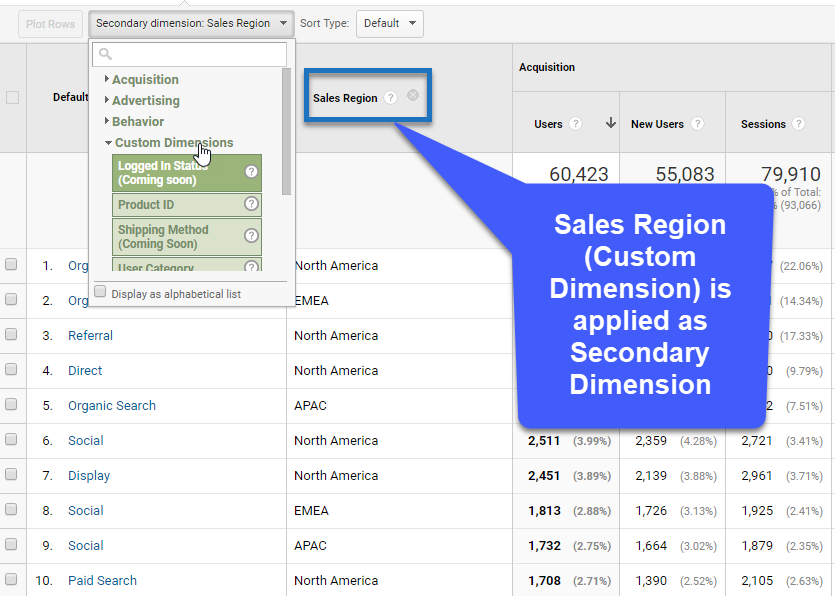The Greatest Guide To What Is A Secondary Dimension In Google Analytics
Wiki Article
Fascination About What Is A Secondary Dimension In Google Analytics
Table of ContentsSee This Report on What Is A Secondary Dimension In Google AnalyticsSome Known Facts About What Is A Secondary Dimension In Google Analytics.Unknown Facts About What Is A Secondary Dimension In Google AnalyticsThe What Is A Secondary Dimension In Google Analytics PDFs
If this does not appear clear, right here are some examples: A purchase happens on a web site. Its dimensions can be (however are not limited to): Deal ID Coupon code Newest website traffic source, and so on. A user visit to a site, as well as we send out the event login to Google Analytics. That event's custom measurements may be: Login approach Individual ID, and so on.Also though there are lots of dimensions in Google Analytics, they can not cover all the feasible circumstances. Hence personalized dimensions are required. Things like Web page link are universal and also put on lots of situations, but what happens if your company offers on-line courses (like I do)? In Google Analytics, you will not locate any type of measurements related particularly to on the internet courses.
Go Into Personalized Capacities. In this blog site message, I will not dive deeper into customized dimensions in Universal Analytics.

The range defines to which occasions the dimension will use. In Universal Analytics, there were four extents: User-scoped personalized measurements are applied to all the hits of an individual (hit is an event, pageview, and so on). If you send User ID as a custom-made measurement, it will certainly be applied to all the hits of that certain session And also to all the future hits sent by that individual (as long as the GA cookie remains the exact same).
The 8-Minute Rule for What Is A Secondary Dimension In Google Analytics
You could send the session ID custom-made measurement, and also also if you send it with the last event of the session, all the previous occasions (of the exact same session) will obtain the worth. This is performed in the backend of Google Analytics. dimension applies just to that particular event/hit (with which the measurement was sent)
That measurement will be used just to the "trial started" occasion. Product-scoped custom measurement applies just to a specific product (that is tracked with Enhanced Ecommerce functionality). Also if you send out numerous items with the very same deal, each product might have different values in their product-scoped custom-made dimensions, e. g.
Why am I telling you this? Due to the fact that some things have altered in Google Analytics 4. In Google Analytics 4, the session range is no more available (at least in custom dimensions). Google stated they would certainly add session-scope in the future to GA4. If you wish to use a measurement to all the occasions of a particular session, you need to send out that dimension with every occasion (that can be done on the code degree (gtag) or in GTM).
The Of What Is A Secondary Dimension In Google Analytics
It can be in a cookie, information layer, or somewhere else. From now on, customized dimensions are either hit-scoped or user-scoped (formerly referred to as User Qualities). User-scoped custom dimensions in GA4 job similarly to the user-scoped dimensions in Universal Analytics but with some differences: In Universal Analytics, a user-scoped custom measurement (set in the center of the customer session) was related to EVERY occasion of the exact same session (also if some occasion occurred before the measurement was set).Even though you can send out custom product information to GA4, at the minute, there is no means to see it in reports correctly. (allow me recognize). At some point in the past, Google stated that session-scoped custom-made dimensions in GA4 would be available as well.
However when it concerns custom dimensions, this scope is still not offered. And currently, allow's relocate to the 2nd component of this blog article, where I will certainly show you just how to set up personalized measurements as well as where to discover them in Google Analytics 4 reports. Allow me start with a general overview resource of the procedure, and then we'll take an appearance at an example.

You can simply send the occasion name, state, "joined_waiting_list" and also after that include the parameter "course_name".
What Is A Secondary Dimension In Google Analytics Can Be Fun For Everyone
In that situation, you will need to: Register a specification as a personalized interpretation Start sending Going Here personalized criteria with the occasions you desire The order DOES NOT issue right here. You must do that rather a lot at the same time. If you start sending out the specification to Google Analytics 4 and only register it as a personalized measurement, state, one week later on, your reports will be missing that week of data (since the registration of a personalized dimension is not retroactive).Whenever a site visitor clicks on a food selection thing, I will send out an event as well as 2 extra criteria (that I will certainly later sign up as personalized measurements), menu_item_url, as well as menu_item_name.: Food selection web link click monitoring trigger problems vary on many websites (due to different click courses, IDs, etc). Try to do your finest to use this example.
Go to Google Tag Manager > Sets Off > New > Just Links. By developing this trigger, we will allow the link-tracking functionality in Google Tag Supervisor.
Go to your web site and click any of the food selection web links. In fact, click at the very least two of them. Return to the sneak peek setting, as well as you ought to start seeing Link Click occasions in the sneak peek setting. Click the very first Web link, Click event as well as go to click for source the Variables tab of the sneak peek mode.
Report this wiki page